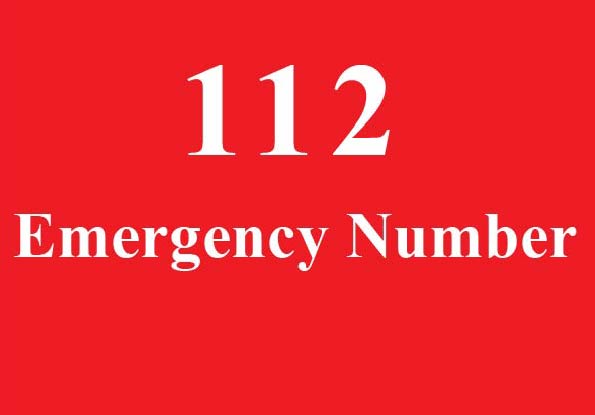
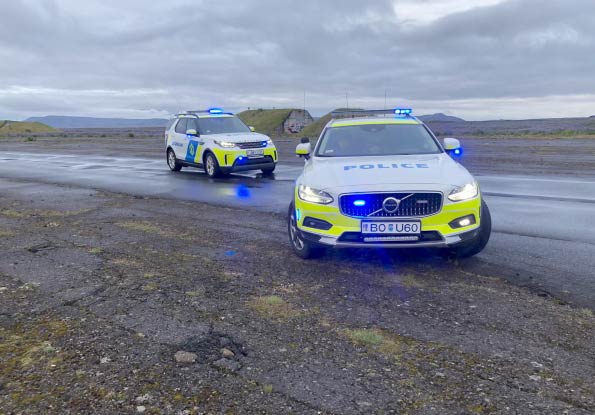
Unforeseen events, such as illnesses, accidents, and natural events, can disrupt our travel plans. In such situations, Emergency line 112 becomes our lifeline and is available 24/7, every day, and you can call anywhere, ensuring immediate assistance in times of need.
While we may not anticipate anything beyond minor flight delays due to bad weather, plane failure, or other standard travel delays, we must be prepared for unforeseen events during our trip. This preparedness includes knowing how to respond appropriately to such events, which can help reduce risks and ensure our safety. Equally important is knowing whom to contact for proper assistance in such situations.
The Emergency line is your comprehensive support system in times of need, and you can call when unforeseen events occur on land, sea, or air. The Emergency line mobilizes a range of responders to help at the scene, including the fire brigade, the ambulances, the police, The Department of Civil Protection and Emergency Management, and rescue teams. When there is no need to send a response person to the scene, the Emergency line contacts the referring person. Referrals include Doctors on call, Health care centers, the Poison control center, and the Emergency room at the National Hospital so they can prepare for your visit.
When you call the Emergency line 112, it's crucial to provide detailed information about what happened. How many people have been involved in the incident and give the exact location where the incident occurred. The more precise the information the Emergency line receives, the more targeted the assistance will be, and the aid will arrive sooner. It's your responsibility to secure the scene of an incident to reduce the risk of further events and, simultaneously, to ensure your safety. Never take unnecessary risks when your safety is at stake. You must provide first aid to those who need it, e.g., to ensure breathing and stop bleeding. The Emergency line guides you by phone about first aid, which you can give to those who need it at the incident place while waiting for help.

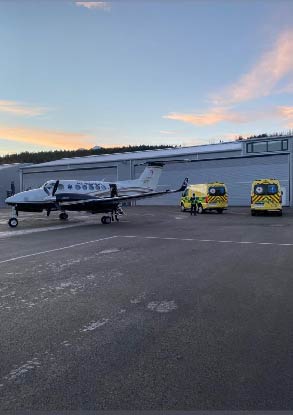
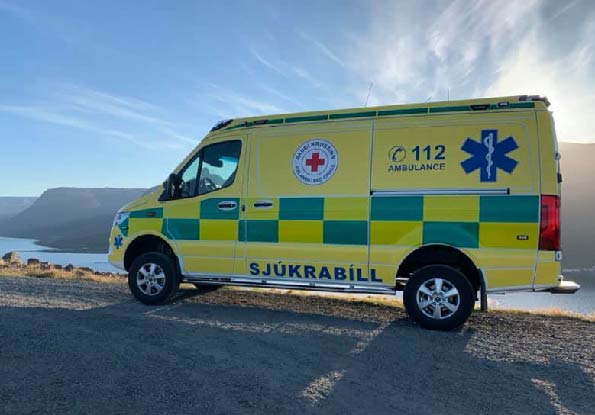

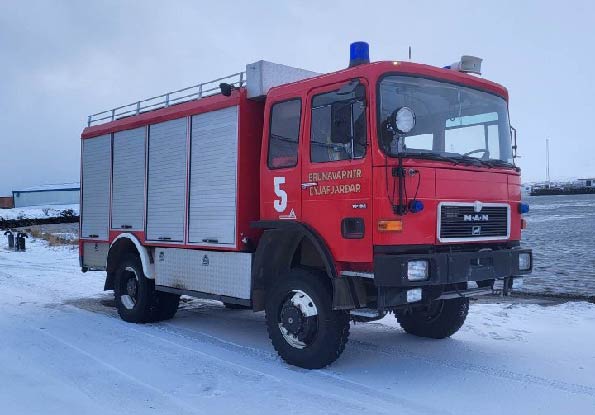
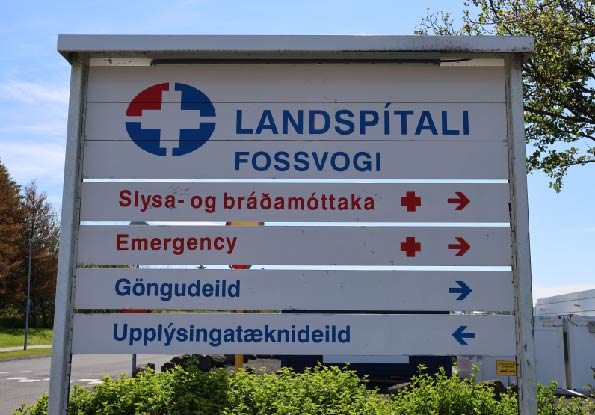
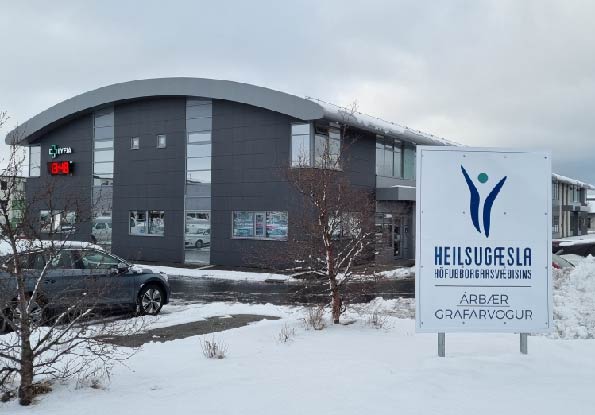
Illness and accidents can be unexpected. The Emergency line 112 is available 24/7, every day of the year, and can be called anywhere in Iceland.
Illnesses and accidents of varying severity can occur. If you are not seriously ill, call 513 1700, 24/7 phone service, for assistance with health-related problems. If necessary, you must visit a clinic or hospital emergency room for medical help.
In the most severe cases, Emergency line 112 should be called for an ambulance or medical helicopter, usually bringing a doctor to the scene.
If you are still deciding whether to get help, call Emergency line 112. A doctor usually evaluates whether to send an ambulance or a medical helicopter.
On the following pages is a list of Health Care Centers, Hospital Emergency rooms, and Police Stations with addresses, phone numbers, and Emergency telephone numbers you can contact for assistance if necessary, and they are sorted by region.
Southern part. Health clinics and Police stations
Eastern part. Health clinics and Police stations
Northern part. Health clinics and Police stations
Western part. Health clinics and Police stations
Southwestern part. Health clinics and Police stations
Northwestern part. Health clinics and Police stations
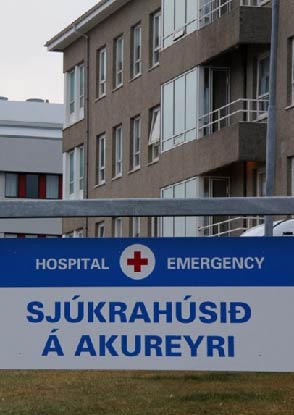
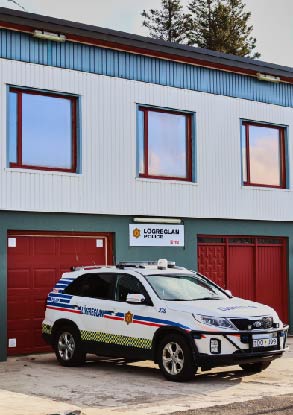
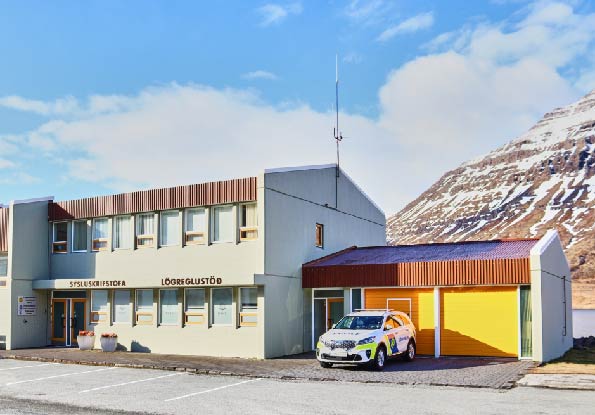


| Name of Health clinics | Address | Code | Tel. | EmTel. |
|---|---|---|---|---|
| Heilsugæslan Hella | Suðurlandsvegi 3 | +354 | 480-5320 | 112 |
| Heilsugæslan Hveragerði | Breiðumörk 25b | +354 | 480-5250 | 112 |
| Heilsugæslan Hvolsvöllur | Öldubakka 4 | +354 | 480-5330 | 112 |
| Heilsugæslan Höfn | Víkurbraut 31 | +354 | 470-8600 | 112 |
| Heilsugæslan Kirkjubæjarklaustur | Skriðuvöllum 13 | +354 | 480-5350 | 112 |
| Heilsugæslan Laugarás | Laugarási | +354 | 432-2770 | 112 |
| Heilsugæslan Selfoss | Árvegi | +354 | 432-2000 | 112 |
| Heilsugæslan Vestmannaeyjar | Sólhlíð 10 | +354 | 481-1955 | 112 |
| Heilsugæslan Vík | Hátúni 2 | +354 | 480-5340 | 112 |
| Heilsugæslan Þorlákshöfn | Selvogsbraut 24 | +354 | 480-5240 | 112 |
| Name of Police stations | Address | Code | Tel. | EmTel. |
|---|---|---|---|---|
| Lögreglustöðin Vestmannaeyjar | Faxastígur 42 | +354 | 444-2090 | 112 |
| Lögreglustöðin Hvolsvöllur | Hlíðarvegur 16 | +354 | 444-2010 | 112 |
| Lögreglustöðin Selfoss | Hörðuvellir 1 | +354 | 444-2010 | 112 |
| Lögreglustöðin Höfn | Hafnarbraut 36 | +354 | 444-2050 | 112 |
| Lögreglustöðin Vík | Ránarbraut 1 | +354 | 444-2010 | 112 |
| Lögreglustöðin Kirkjubæjarklaustur | Iðjuvellir 7 | +354 | 444-2010 | 112 |
| Name of Health clinics | Address | Code | Tel. | EmTel. |
|---|---|---|---|---|
| Heilsugæslan Borgarfjörður eystri | Heiðargerði | +354 | 472-9945 | 112 |
| Heilsugæslan Breiðdalsvík | Selnesi 44 | +354 | 470-3099 | 112 |
| Heilsugæslan Djúpivogur | Eyjalandi 2 | +354 | 470-3090 | 112 |
| Heilsugæslan Egilsstaðir | Lagarási 22 | +354 | 470-1400 | 112 |
| Heilsugæslan Eskifjörður | Strandgötu 31 | +354 | 470-1430 | 112 |
| Heilsugæslan Fáskrúðsfjörður | Hlíðargötu 60 | +354 | 470-3080 | 112 |
| Heilsugæslan Neskaupstaður | Mýrargötu 20 | +354 | 470-1450 | 112 |
| Heilsugæslan Reyðarfjörður | Búðareyri 8 | +354 | 470-1420 | 112 |
| Heilsugæslan Seyðisfjörður | Suðurgötu 8 | +354 | 472-1406 | 112 |
| Heilsugæslan Stöðvarfjörður | Túngötu 2 | +354 | 470-3088 | 112 |
| Heilsugæslan Vopnafjörður | Laxdalstúni | +354 | 470-3070 | 112 |
| Name of Police stations | Address | Code | Tel. | EmTel. |
|---|---|---|---|---|
| Lögreglustöðin Eskifjörður | Strandgötu 52 | +354 | 444-0600 | 112 |
| Lögreglustöðin Egilsstaðir | Lyngási 15 | +354 | 444-0640 | 112 |
| Lögreglustöðin Fáskrúðsfjörður | Skólavegur 53 | +354 | 444-0660 | 112 |
| Lögreglustöðin Neskaupstaður | Melagata 2a | +354 | 444-0620 | 112 |
| Lögreglustöðin Djúpavogur | Bakka 3 | +354 | 444-0665 | 112 |
| Lögreglustöðin Vopnafjörður | Lónabraut 2 | +354 | 444-0610 | 112 |
| Name of Health clinics | Address | Code | Tel. | EmTel. |
|---|---|---|---|---|
| Heilsugæslan Akureyri | Glerárgötu 9 | +354 | 460-4600 | 112 |
| Heilsugæslan Blönduós | Flúðabakka 2 | +354 | 455-4100 | 112 |
| Heilsugæslan Dalvík | Hólavegi | +354 | 466-1500 | 112 |
| Heilsugæslan Grímsey | Múla | +354 | 432-4600 | 112 |
| Heilsugæslan Hofsós | Suðurbraut 15 | +354 | 453-7354 | 112 |
| Heilsugæslan Húsavík | Auðbrekku 4 | +354 | 464-0500 | 112 |
| Heilsugæslan Kópasker | Akurgerði 13 | +354 | 464-0640 | 112 |
| Heilsugæslan Laugar | Laugum | +354 | 464-0650 | 112 |
| Heilsugæslan Ólafsfjörður | Hornbrekku | +354 | 466-4050 | 112 |
| Heilsugæslan Raufarhöfn | Aðalbraut 33 | +354 | 464-0620 | 112 |
| Heilsugæslan Reykjahlíð | Helluhrauni 17 | +354 | 464-0660 | 112 |
| Heilsugæslan Sauðárkrókur | Sauðárhæðum | +354 | 455-4000 | 112 |
| Heilsugæslan Siglufjörður | Hvanneyrarbr. 37 | +354 | 460-2100 | 112 |
| Heilsugæslan Skagaströnd | Ægisgrund 16 | +354 | 432-4150 | 112 |
| Heilsugæslan Þórshöfn | Miðholti 2 | +354 | 464-0600 | 112 |
| Sjúkrahúsið á Akureyri | Eyrarlandsvegi | +354 | 463-0800 | 112 |
| Name of Police stations | Address | Code | Tel. | EmTel. |
|---|---|---|---|---|
| Lögreglustöðin Akureyri | Þórunnarstræti 138 | +354 | 444-2800 | 112 |
| Lögreglustöðin Húsavík | Útgarði 1 | +354 | 444-2850 | 112 |
| Lögreglustöðin Fjallabyggð | Gránugötu 4-6 | +354 | 444-2860 | 112 |
| Lögreglustöðin Þórshöfn | Eyrarvegi 2 | +354 | 444-2855 | 112 |
| Lögreglustöðin Dalvík | Gunnarsbraut 6 | +354 | 444-2865 | 112 |
| Lögreglustöðin Sauðárkrókur | Suðurgötu 1 | +354 | 444-0700 | 112 |
| Lögreglustöðin Blönduós | Hnjúkabyggð 33 | +354 | 444-0720 | 112 |
| Name of Health clinics | Address | Code | Tel. | EmTel. |
|---|---|---|---|---|
| Heilsugæslan Akranes | Merkigerði 9 | +354 | 432-1000 | 112 |
| Heilsugæslan Borgarnes | Borgarbraut 65 | +354 | 437-1400 | 112 |
| Heilsugæslan Búðardalur | Gunnarsbraut 2 | +354 | 432-1450 | 112 |
| Heilsugæslan Grundarfjörður | Hrannarstíg 7 | +354 | 430-6800 | 112 |
| Heilsugæslan Hólmavík | Borgabraut 6-8 | +354 | 432-1400 | 112 |
| Heilsugæslan Hvammstangi | Spítalastíg 1 | +354 | 432-1300 | 112 |
| Heilsugæslan Ólafsvík | Engihlíð 28 | +354 | 430-6500 | 112 |
| Heilsugæslan Reykhólar | Reykhólum | +354 | 432-1460 | 112 |
| Heilsugæslan Stykkishólmur | Austurgötu 7 | +354 | 432-1200 | 112 |
| Name of Police stations | Address | Code | Tel. | EmTel. |
|---|---|---|---|---|
| Lögreglustöðin Snæfellsbæ | Bankastræti 1a | +354 | 444-0300 | 112 |
| Lögreglustöðin Grundarfjörður | Hrannarstíg 2 | +354 | 444-0300 | 112 |
| Lögreglustöðin Stykkishólmur | Borgarbraut 2 | +354 | 444-0300 | 112 |
| Lögreglustöðin Akranes | Þjóðbraut 13 | +354 | 444-0300 | 112 |
| Lögreglustöðin Búðardalur | Miðbraut 11 | +354 | 444-0300 | 112 |
| Name of Health clinics | Address | Code | Tel. | EmTel. |
|---|---|---|---|---|
| Heilsugæslan Árbær | Hraunbæ 115 | +354 | 585-7800 | 112 |
| Heilsugæslan Efra-Breiðholt | Hraunbergi 6 | +354 | 513-1550 | 112 |
| Heilsugæslan Efstaleiti | Efstaleiti 3 | +354 | 585-1800 | 112 |
| Heilsugæslan Fjörður | Fjarðargötu 13-15 | +354 | 540-9400 | 112 |
| Heilsugæslan Garðabær | Garðatorgi 7 | +354 | 520-1800 | 112 |
| Heilsugæslan Glæsibær | Álfheimum 74 | +354 | 599-1300 | 112 |
| Heilsugæslan Grafarvogur | Spöngin 35 | +354 | 585-7600 | 112 |
| Heilsugæslan Hamraborg | Hamraborg 8 | +354 | 594-0500 | 112 |
| Heilsugæslan Hlíðar | Drápuhlíð 14-16 | +354 | 585-2300 | 112 |
| Heilsugæslan Hvammur | Hagasmára 5 | +354 | 594-0400 | 112 |
| Heilsugæslan Höfði | Bíldshöfða 9 | +354 | 591-7000 | 112 |
| Heilsugæslan Miðbær | Vesturgötu 7 | +354 | 585-2600 | 112 |
| Heilsugæslan Mjódd | Þönglabakka 6 | +354 | 513-1500 | 112 |
| Heilsugæslan Mosfellsbær | Þverholti 2 | +354 | 510-0700 | 112 |
| Heilsugæslan Salahverfi | Salavegi 2 | +354 | 590-3900 | 112 |
| Heilsugæslan Seltjarnarnes | Suðurströnd | +354 | 513-2100 | 112 |
| Heilsugæslan Sólvangur | Sólvangsvegi 2 | +354 | 550-2600 | 112 |
| Heilsugæslan Urðarhvarf | Urðarhvarfi 14 | +354 | 510-6550 | 112 |
| Heilsugæslan Kirkjusandur | Hallgerðargötu 13 | +354 | 595-1300 | 112 |
| Læknavaktin | Háaleitisbraut 68 | +354 | 1770/1700 | 112 |
| Landspítali | Fossvogi, Hringbraut | +354 | 543-1000 | 112 |
| Heilsugæslan Grindavík | Víkurbraut 62 | +354 | 422-0750 | 112 |
| Heilsugæslan Reykjanesbær | Skólavegi 6 | +354 | 422-0500 | 112 |
| Name of Police stations | Address | Code | Tel. | EmTel. |
|---|---|---|---|---|
| Lögreglustöðin Hverfisgata | Hverfisgata 113-115 | +354 | 444-1000 | 112 |
| Lögreglustöðin Vínlandsleið | Vínlandsleið 2-4 | +354 | 444-1000 | 112 |
| Lögreglustöðin Dalvegur | Dalvegur 18 | +354 | 444-1000 | 112 |
| Lögreglustöðin Hafnarfjörður | Flatahraun 11 | +354 | 444-1000 | 112 |
| Lögreglustöðin Reykjanesbær | Hringbraut 130 | +354 | 444-2200 | 112 |
| Lögreglustöðin Grindavík | Víkurbraut 25 | +354 | 444-2200 | 112 |
| Lögreglustöðin Vogar | Hafnargötu 17 | +354 | 444-2200 | 112 |
| Lögreglustöðin Suðurnesjabæ | Miðnestorgi 3 | +354 | 444-2200 | 112 |
| Name of Health clinics | Address | Code | Tel. | EmTel. |
|---|---|---|---|---|
| Heilsugæslan Bíldudalur | Hafnarbraut 15 | +354 | 450-4500 | 112 |
| Heilsugæslan Bolungarvík | Aðalstræti 12 | +354 | 456-7147 | 112 |
| Heilsugæslan Flateyri | Eyrarvegi 8 | +354 | 450-4500 | 112 |
| Heilsugæslan Ísafjörður | Torfnesi | +354 | 450-4500 | 112 |
| Heilsugæslan Patreksfjörður | Stekkum 1 | +354 | 450-2000 | 112 |
| Heilsugæslan Suðureyri | Aðalgötu 2 | +354 | 456-6144 | 112 |
| Heilsugæslan Súðavík | Grundarstræti 1 | +354 | 456-4966 | 112 |
| Heilsugæslan Tálknafjörður | Strandgötu 38 | +354 | 450-4500 | 112 |
| Heilsugæslan Þingeyri | Vallargötu 7 | +354 | 456-8122 | 112 |
| Name of Police stations | Address | Code | Tel. | EmTel. |
|---|---|---|---|---|
| Lögreglustöðin Ísafjörður | Hafnarstræti 1 | +354 | 444-0400 | 112 |
| Lögreglustöðin Hólmavík | Skeiði 2 | +354 | 444-0420 | 112 |
| Lögreglustöðin Patreksfjörður | Aðalstræti 92 | +354 | 444-0400 | 112 |
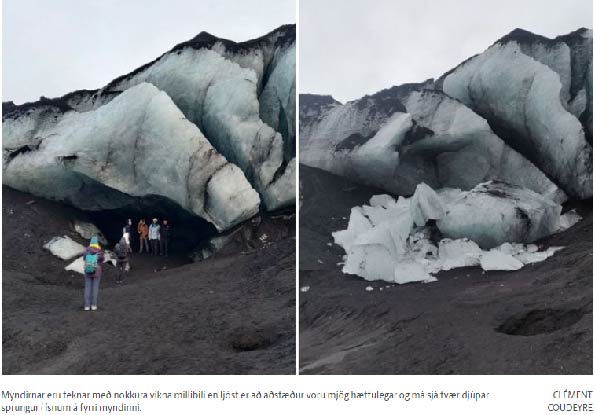
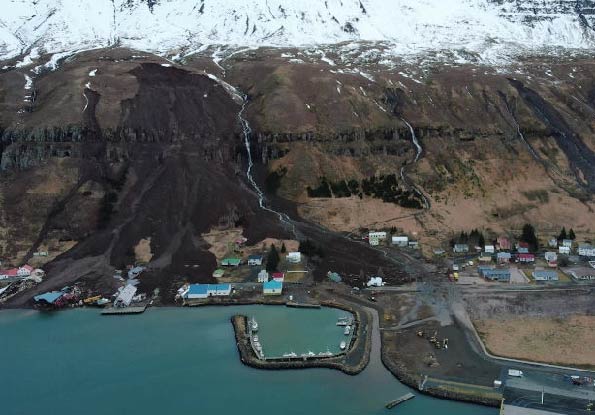
Natural events of varying severity can occur after the trip has begun. Such events include volcanic eruptions, earthquakes, floods, landslides, rockfalls, avalanches, and tsunamis.
If you become aware of a natural event, report it to the Emergency line 112 and ask for emergency assistance if necessary.
In some natural events, brief omens can indicate what is to come, but in some, there are no warnings, and then you must listen to the radio and check SafeTravel.is for further instructions. Sometimes, you will receive a text message on your mobile phone telling you how to react.
If a natural event is expected or has started, the civil defense response system is activated, and you must leave the danger area according to instructions. The Department of Civil Protection and Emergency Management manages the response to natural events and accidents that may threaten public safety.
When natural events occur, it may be necessary to change the travel plan to reduce risk.
A brief description of natural events and how to react correctly and in time when natural events occur. You can take a closer look by activating the links below.
How to reduce risk and who to contact
Volcanic eruptions and glacial runoff
Landslides and rockfalls
Avalanches
Earthquakes
Tsunamis
Strong currents and powerful waves
Ice caves in glaciers, rock and lava caves
Natural events are usually majestic sights. Do not take unnecessary risks by staying too long in the danger zone, e.g., when photographing natural events in progress. Leave the danger zone immediately to ensure your safety and the safety of your fellow passengers.


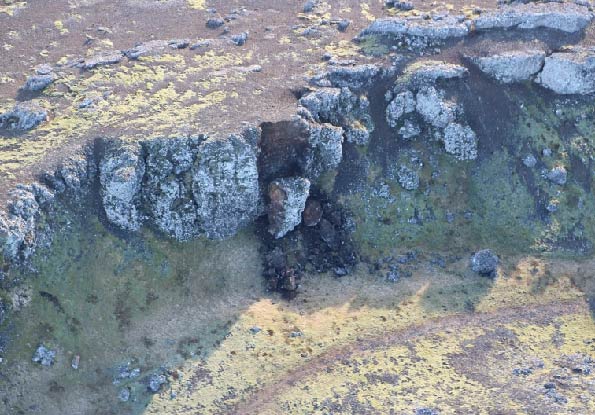
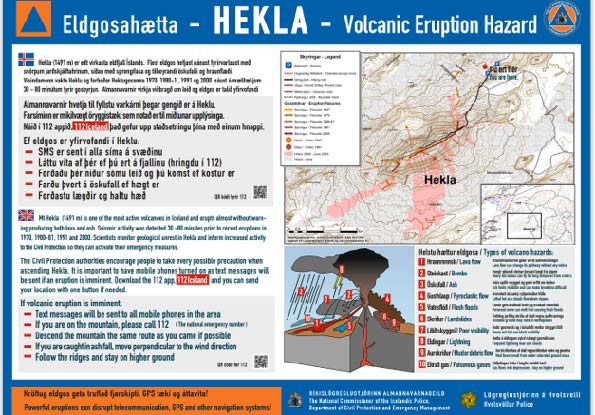
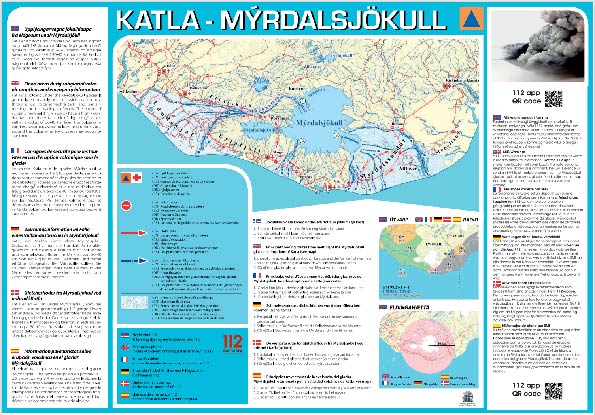
How to act to reduce risk and who to contact for help
The Department of Civil Protection and Emergency Management monitors volcanic eruptions, lava flows, ashfall, glacial runoff, and earthquakes. The contingency plan is about monitoring volcanic areas if an eruption is expected, and if an eruption has started, the area is closed to traffic. The Department of Civil Protection and Emergency Management sends a text message to all mobile transmitters in the affected area when an eruption is imminent or has started. Listen to announcements, news in the media, and SafeTravel.is and follow any instructions. Pay close attention to weather reports, ash fall, and gas forecasts. A glacial run always accompanies volcanic eruptions under a glacier. If there is a risk of a glacier run, go to a place higher than the one. If there is flooding in the area, report it to the Emergency line, but if that is not possible, put up a white wave to signal that you need help.
If there is an ash fall, take the shortest route out of the ash fall by going against the wind direction. Stay downwind and never descend into a low-lying country, as gas can accumulate there. The gas is a deadly poison and, in most cases, is odorless and invisible.
A volcanic eruption is a majestic and rare sight. However, volcanoes can be hazardous, so it is better to stay away if one starts.
Volcanic eruptions and glacial runoff
Earthquakes are often a precursor to volcanic eruptions. Seismic activity increases and more significant earthquakes co-occur as the land rises or falls, ground temperatures rise, and river water rises. Earthquakes in and around volcanoes and volcanic expansions are always a harbinger, usually ending in an eruption, but the process can take several years.
An eruption can start without warning, disrupting road transport, damaging the country's electricity grid, and stopping flights. Then, a lot of ash can fall, temporarily polluting the atmosphere.
Lava can flow, and life-threatening toxic fumes can be formed, which fall to the ground, so you must have a gas meter with you, which will let you know if the gas level exceeds the limit if you enter an area with an eruption. If there is an eruption under a glacier, you can expect much water in the glacier river because the ice above the volcano melts due to the heat from the eruption. If you are in such an area, it is safer to go to a place that lies higher where lava and water do not reach, but you still must be careful of rock falls.
Five of the country's most potent and active volcanoes are considered ready or preparing to erupt. The volcanoes considered very active are being monitored: Öræfajökull, Bárðarbunga, Grímsvötn, Hekla, and Katla.
Öræfajökull is in the southern part of Vatnajökull and is the largest volcano in the country. The last eruption was in 1727, or about three hundred years ago. It is believed that Öræfajökull will erupt soon as many earthquakes have been recorded in the glacier, which has been expanding for several years.
Bárðarbunga is in the northwestern part of Vatnajökull. The last volcanic eruption was in Bárðarbunga in 2014 when a fissure opened outside the glacier in Holuhraun, and lava erupted. Soon after the Holuhraun eruption ended, earthquakes began to increase in the area, and the volcano expanded.
Grímsvötn are on the west side of Vatnajökull. The last volcanic eruption was in Grímsvötn in 2011, but in that eruption, there was much ash fall in the settlement. Earthquakes increased in the area, and the volcano expanded. It is believed that Grímsvötn shows all the signs of preparing for the next eruption. Volcanic eruptions in Grímsvötn are accompanied by glacial runoff. Then, the water in the glacial channel increases because the ice above the volcano melts, and the water flows into the glacial channel.
Hekla is in the southern countryside. The last eruption was in February 2000, and before that, in January 1991, 1980, 1970, and finally, a mighty eruption began in March 1947, which lasted for over a year. The eruptions have been short eruptions of lava with little pyroxene. Usually, volcanic eruptions start without warning. Earthquakes only accompany Hekla eruptions around the time the eruption begins and, therefore, cannot be considered harbingers of eruptions.
Katla is in the southeastern part of Mýrdalsjökull. The last volcanic eruption was in 1918. Volcanic eruptions in Katla are usually explosive eruptions, accompanied by a lot of pyroclastic falls and a significant increase in water in the rivers that flow down Mýrdalssandur. It is estimated that it only takes less than three hours from the start of the eruption until the water has reached the sea. Large icebergs can be in the water flow. It is believed that Katla is the most dangerous volcano because the mountain's volcanism is high, and it is located near a settlement.
Askja in Dyngjufjöll is in the northern highlands. Askja is not one of the five most active volcanoes in the country. The last eruption was in 1961 when Vikrahraun erupted. Herðubreið is an inactive volcano. North of Herðubreið, the number of earthquakes has increased, and the volcano has begun to expand. Askja is believed to be preparing for an eruption.
Landslides and rockfalls
Landslides and rockfalls are events that happen quickly and often without warning and are usually very dangerous. Assessing the risk of landslides and rock falls in the travel area is necessary. Landslides and rockfalls are expected in autumn and spring. Mountain slopes are often unstable, and it only takes a small amount of rain or air temperature changes to trigger landslides or rockfalls. With warm weather, an increase in landslides and rock falls can be expected. When it rains a lot, water usually grows in rivers and streams. If rivers and streams overflow their banks, there is a greater risk of landslides, especially when it has been raining for several days. In warm weather, wind, rain, and when the snow melts, there is a greater risk of landslides and rock falls, which can fall from steep mountain slopes. Do not be outdoors, and do not go to mountainous areas with a risk of landslides and rock falls. Stay on the side of the house that does not face the hillside, close the windows, and put shutters on the windows facing the hillside. Going down into a basement can be dangerous, as it can fill with thin, watery soil and block all exits.
If your companion is caught in a landslide, mark the area where your companion was last seen and start a search immediately. Remember that a landslide can fall again, so you must leave the danger zone immediately to ensure your safety. If you must cross a danger zone, be careful and find a safe place to stop. Only one of your companions crosses the danger zone at a time, so the other companions can react if another landslide occurs.
If a landslide hits you, you must try to stay out of the landslide to ensure breathing. If you cannot get out of the landslide, you should kneel and protect your head. Cover your eyes, mouth, and nose to prevent them from filling with mud. When the landslide starts to stop, you need to move to create space for movement. Get up, move out of the path, and move to a higher ground than where the landslide occurred.
If there is a rockfall, try to position yourself so that you will not be hit by the rock rolling down the mountainside at high speed.
Try to be calm and composed, as you are more likely to make the right decisions. Immediately call the Emergency line 112 to report what has happened and ask for emergency assistance if necessary.
The Icelandic Meteorological Office monitors the situation and assesses the risk of further landslides and rockfalls in settlements. If there is a risk of landslides or rock falls, leave the danger area following the instructions of the Department of Civil Protection and Emergency Management.
Avalanche
An avalanche is an event that happens quickly and often without warning and is usually very dangerous. One of the most destructive aspects of winter travel is the risk of avalanches, so it is essential to assess and recognize the signs of when there is a risk of avalanches in the travel area. Signs of potential avalanche danger are recent avalanches that have fallen in the area, newly fallen snow poorly connected to older snow, snowballs rolling down the mountainside, and snow accumulating on steep mountain slopes when the slope exceeds 30°. Earthquakes can also cause avalanches. When going in mountainous terrain on snowmobiles, snowboards, and skis, where there is a risk of avalanches, be careful not to cross steep mountain slopes and take unnecessary turns when going down steep mountain slopes because this can cause an avalanche. If you must cross a dangerous avalanche zone, be careful and find a safe place to stop. Then, only one of your fellow travelers crosses the danger zone at a time, so your other fellow travelers can react if the avalanche falls again. Remember that avalanches can fall again, so you must leave the danger zone immediately to ensure your safety. The safest trails are on ridges and weathered slopes, and where the snow is shallowest, rocks emerge from the snow.
If a fellow traveler is caught in an avalanche, mark where the fellow traveler was last seen and start a search immediately. The fellow traveler must try to swim to get out of the avalanche. Cover his eyes, mouth, and nose to prevent them from filling with snow. When the avalanche starts to stop, the fellow traveler must move to create space for movement and breathing. Try to be calm and composed because you are more likely to make the right decisions. Immediately call the Emergency line, report what has happened, and ask for emergency assistance if necessary.
The Icelandic Meteorological Office and avalanche inspectors monitor the risk of avalanches in settlements. If there is a risk of avalanches, leave the danger area following the instructions of the Department of Civil Protection and Emergency Management.
Earthquakes
An earthquake is an event that happens suddenly and usually without warning. It can be dangerous because objects and building parts can fall on you. An earthquake can also cause landslides, rockfalls, avalanches, and tsunamis and can be a harbinger of a volcanic eruption. Different reactions to earthquakes depend on whether you are indoors, outdoors, or traveling in a vehicle.
Suppose you are indoors when an earthquake starts. Go under a table or bed, crouch in a corner by a load-bearing wall, or in a door by a load-bearing wall. Protect your head and face with a pillow if you wake up during an earthquake. Do not be near tall furniture as it may fall on you, and do not be near windows as the glass in the windows may break and cut you. Use extreme caution and check the escape route out of the house after the earthquake and move to a safe distance from the house in case it collapses.
If you are outdoors when you feel an earthquake, try to get to a safe place and get away from objects and buildings that could fall on you. Avoid rockfalls, landslides, and avalanches that can fall from slopes and mountains during the earthquake. Avoid touching or being near power lines because they can wear out and fall to the ground in an earthquake. Power lines are hazardous if they break because the electricity can still be on the power line. Move from the coast to higher ground in a tsunami hazard zone. Go to an open area where there is no danger.
Suppose you are driving on a highway when you feel an earthquake. Find a safe place and stop the vehicle because roads and bridges can be damaged in an earthquake. Fasten your seat belt and stay in the vehicle. The vehicle can protect you from the consequences of an earthquake.
The Icelandic Meteorological Office monitors earthquakes. The civil defense response system is activated when a large earthquake occurs. Listen to the radio, where the first information about the quake usually comes from. If danger arises, leave the danger area following the instructions from the Department of Civil Protection and Emergency Management.
Tsunamis
A tsunami is an event that occurs quickly and often with little or no warning and is extremely dangerous. Sea or lake waves (tsunamis) are formed if soil or snow flows into the sea or water in large quantities following an earthquake or heavy rains. In doing so, the surface of the ocean or lake rises and creates a high wave (tsunami) that can go ashore. The same happens if there is an underwater volcanic eruption or earthquake, when the plates of the continental shelf move underwater, or when a landslide occurs on the continental shelf (ocean floor).
If you are caught in a tsunami, you need to swim to try to stay on the surface of the tsunami to ensure breathing. If you cannot swim, try to cover your eyes, mouth, and nose to prevent them from filling with water, mud, or snow.
Tsunamis are rare in Iceland, but they can cause significant damage to ships, boats, roads, buildings, and other structures and are extremely dangerous.
The Icelandic Meteorological Office warns of the risk of a tsunami. As soon as a tsunami is expected, the civil defense response system is activated, and a warning is given. Listen to the radio, where you usually get the first information about the danger of a tsunami or check SafeTravel.is. If danger arises, leave the danger area following the instructions of the Department of Civil Protection and Emergency Management.
Strong currents and powerful waves
On all beaches in Iceland, it is a good rule never to turn your back on the waves and not go too close to the waves because it can be life-threatening.
Reynisfjara is in the southern part, and it has been chosen as one of the most beautiful beaches in the world and a popular sightseeing spot in Iceland. However, the beach is hazardous due to strong currents and big waves. Life-threatening large and powerful waves come between small innocent waves, which can take you out to sea. Reynisfjara is deep, and the waves, therefore, reach further ashore.
If you are in Reynisfjara and notice that life-threatening large and powerful waves are taking some persone out to sea with them. Then try to throw rescue equipment, which is in Reynisfjara, at the person who went into the sea, but still take care of your safety and do not go too close to the waves. If you must go near the waves, you need to tie a safety line to you and have someone hold the other end, which is further up the tide and is not in danger, to ensure your safety.
Ice caves in glaciers, rock and lava caves
Ice caves in glaciers form when meltwater or geothermal heat melts the ice. Ice caves are unstable as the ice constantly moves, and if the ice cave is safe today, it may not be secure tomorrow. Ice caves in glaciers are extremely dangerous, and you should avoid entering such ice caves due to the risk of an iceberg falling from walls or ceilings. Rock and lava caves can also be unstable.
If you witness an iceberg, rock, or lava falling on a person, call the Emergency line, explain what has happened, and ask for help if necessary. Then, try to use first aid methods to help the injured person, but first, take care of your safety.
If there is a risk of an iceberg, rock, or lava collapse, follow the Department of Civil Protection and Emergency Management's instructions to leave the danger area.
Always be careful when traveling in Iceland
Iceland's nature is beautiful, but it can also be cruel. When exploring nature or doing activities, take only necessary risks. Be prepared for the situation to be different than expected.